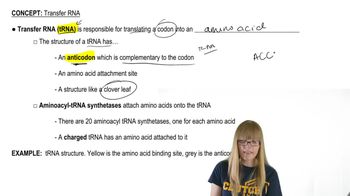Francis Crick proposed the 'adaptor hypothesis' for the function of tRNA. Why did he choose that description?
Table of contents
- 1. Introduction to Genetics51m
- 2. Mendel's Laws of Inheritance3h 37m
- 3. Extensions to Mendelian Inheritance2h 41m
- 4. Genetic Mapping and Linkage2h 28m
- 5. Genetics of Bacteria and Viruses1h 21m
- 6. Chromosomal Variation1h 48m
- 7. DNA and Chromosome Structure56m
- 8. DNA Replication1h 10m
- 9. Mitosis and Meiosis1h 34m
- 10. Transcription1h 0m
- 11. Translation58m
- 12. Gene Regulation in Prokaryotes1h 19m
- 13. Gene Regulation in Eukaryotes44m
- 14. Genetic Control of Development44m
- 15. Genomes and Genomics1h 50m
- 16. Transposable Elements47m
- 17. Mutation, Repair, and Recombination1h 6m
- 18. Molecular Genetic Tools19m
- 19. Cancer Genetics29m
- 20. Quantitative Genetics1h 26m
- 21. Population Genetics50m
- 22. Evolutionary Genetics29m
11. Translation
Transfer RNA
Problem 7c
Textbook Question
Identify the amino acid carried by tRNAs with the following anticodon sequences.
5′-CUC-3′
 Verified step by step guidance
Verified step by step guidance1
Determine the codon sequence that pairs with the given anticodon. Remember that the anticodon sequence on the tRNA is complementary and antiparallel to the mRNA codon. For the anticodon 5′-CUC-3′, the corresponding codon on the mRNA will be 5′-GAG-3′.
Identify the directionality of the codon. Ensure that the codon is read in the 5′ to 3′ direction, which is the standard orientation for mRNA sequences.
Use the genetic code table to find the amino acid corresponding to the codon 5′-GAG-3′. Each codon specifies a particular amino acid.
Verify the amino acid assignment by cross-referencing the genetic code table to ensure accuracy.
Conclude that the tRNA with the anticodon 5′-CUC-3′ carries the amino acid specified by the codon 5′-GAG-3′, based on the genetic code.
 Verified video answer for a similar problem:
Verified video answer for a similar problem:This video solution was recommended by our tutors as helpful for the problem above
Video duration:
1mPlay a video:
Was this helpful?
Key Concepts
Here are the essential concepts you must grasp in order to answer the question correctly.
tRNA and Anticodons
Transfer RNA (tRNA) molecules are essential for translating the genetic code into proteins. Each tRNA has a specific anticodon sequence that pairs with a corresponding codon on the mRNA during translation. The anticodon 5′-CUC-3′ will base pair with the mRNA codon 5′-GAG-3′, which is crucial for determining the amino acid that will be added to the growing polypeptide chain.
Recommended video:
Codon-Amino Acid Relationship
The genetic code consists of codons, which are sequences of three nucleotides in mRNA that specify particular amino acids. Each codon corresponds to a specific amino acid or a stop signal during protein synthesis. The codon GAG, which pairs with the anticodon CUC, codes for the amino acid glutamic acid, highlighting the importance of understanding this relationship in genetics.
Recommended video:
Amino Acids and Protein Synthesis
Amino acids are the building blocks of proteins, and their sequence determines the structure and function of the resulting protein. During translation, amino acids are linked together in the order specified by the mRNA codons. Understanding which amino acid corresponds to a given codon is essential for predicting the properties of the synthesized protein and its role in cellular functions.
Recommended video:
Guided course

Proteins
Related Videos
Related Practice
Textbook Question
766
views



